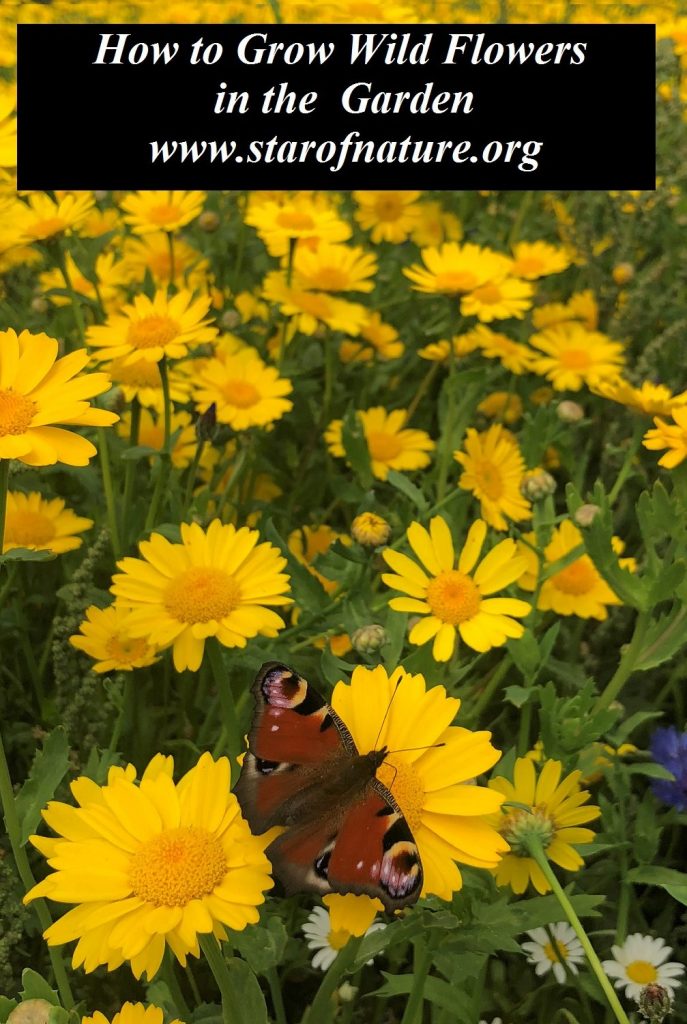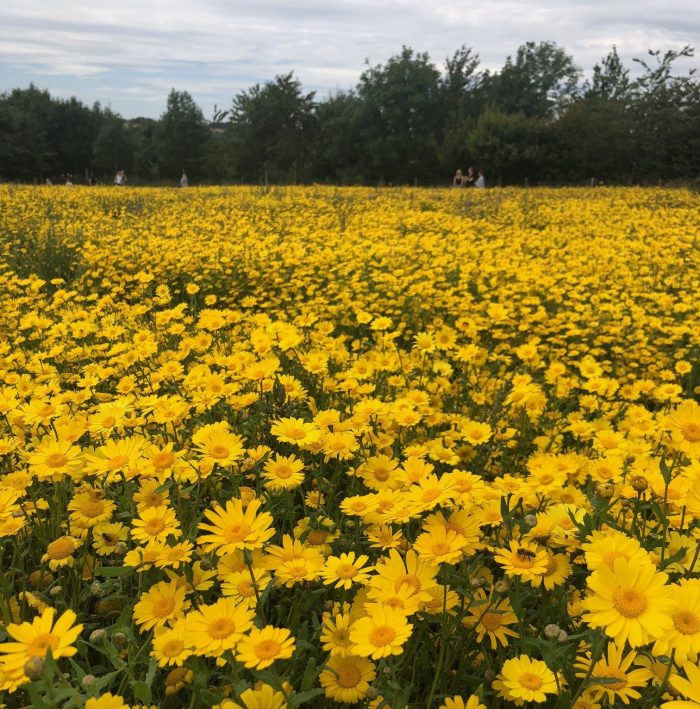How to Grow Wild Flowers in the Garden
Anyone who has seen a wild flower meadow cannot forget this wonderful sight. It is a multi-coloured carpet of flowers and grasses that gracefully move in the wind. A meadow is always full of life – there is a constant sound of insects and birds. There is also a wonderful smell that becomes stronger as the sun warms the flowers. Many of us would like to recreate this beauty in our own gardens. But how does one grow wild flowers? Below I give detailed advice.
What are the advantages of growing wild flowers in the garden?
– Wild flowers are just as beautiful as cultivated flowers. Their colours are extremely varied, and there is a great range of shapes and sizes to choose from.
– A wild flower meadow can look great for the entire season. Crocuses, daffodils, fritillaries, hellebores and primulas flower first in early spring. Most plants bloom in June and July when the meadow reaches the peak of its beauty. Seed heads of flowers and grasses provide interest in August and September.
– Wild flowers look wonderful in arrangements and can be used to decorate home in a distinctive style evoking the sense of comfort and authenticity.
– They are very easy to grow organically – they are resistant to slugs and other pests, and don’t need any fertilizers.
– If chosen well for the conditions of the garden, they require very little effort, and do not need constant mowing, watering or staking.
– Wild flowers are tough and can cope with extreme weather, drought, hard frost, temporary flooding. They can be useful for parts of the garden that are difficult due to uneven surface, poor soil or dryness.
– Some wild flowers are edible or can be used as spices. Many are also used in natural cosmetics.
– Wild flowers attract bees, butterflies, moths and other pollinators to the garden by providing nectar and pollen. As a result vegetables and fruit trees are better pollinated and produce more abundant crops.
– They also attract birds that eat seeds, but also insects we would rather be without, providing natural pest control.
– Growing wild flowers helps to preserve native species, both plants and animals, often threatened in the wild.
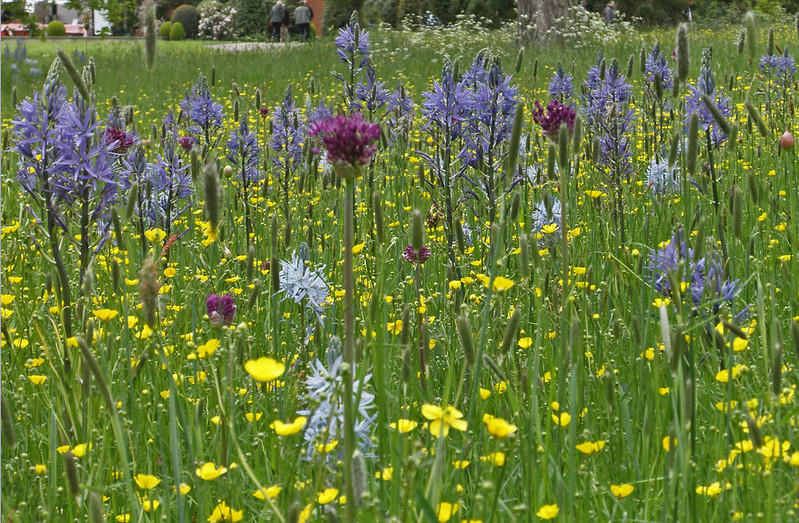
Choosing wild flowers for the garden
When deciding which wild flowers to grow in the garden and how to do it, it is important to take into account the type of soil, and the availability of moisture and light. This will determine the choice of plants and what needs to be done to accommodate them.
Meadow plants require an open sunny position and well-drained soil. Woodland plants will do well in semi-shade and some even in deep shade. There is, of course, a limited choice of plants for more difficult situations, such as dry shade, but they do exist. In nature there are very few areas that have not been colonized by plants.
Wild flowers are best bought from nurseries that specialize in them and know their needs. Such nurseries should be able to explain the plants’ requirements in their printed and online catalogues. Many offer a wide choice of plants for different conditions. They also sell seed mixtures for various situations, such a dry or moist soil, full sun or partial shade.
It is also important to check the growing habits of plants before buying them. For example, how tall do they grow? Should they go to the front or the back of a border? How vigorous are they and are they likely to overwhelm other plants?
Finally, it is worth paying attention to what naturally grows in your area. These are the plants that will be easiest to grow and will attract local insects and birds.
How to use wild flowers in the garden
There different ways of introducing wild flowers in the garden. Below I explain how to grow them in a border, in a herb or vegetable garden, in a lawn, and how to create a wild flower meadow.
1. Wild flowers in a border
Wild flowers do not need to have a dedicated area. They combine well with other plants and some are just as showy as garden flowers. Planting a few in a border is a good solution if you don’t have space or the right soil for a meadow.
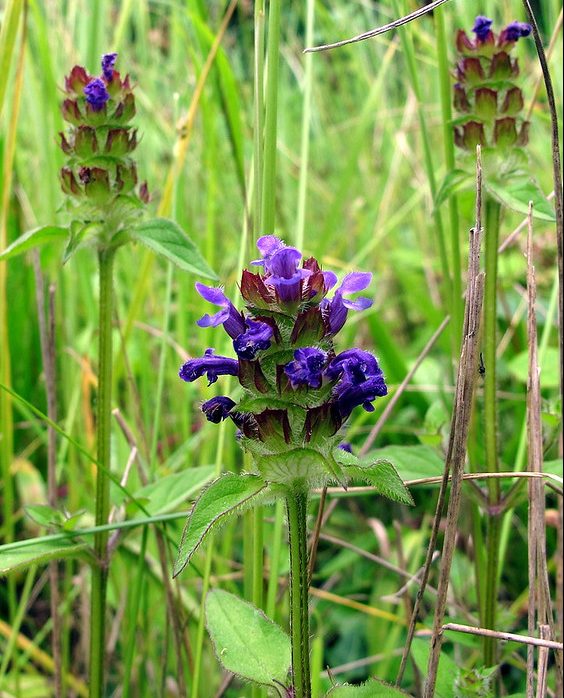
Choosing wild flowers for a border
Wild flowers that work best in a border are ‘well-behaved’, non-invasive species that will not overwhelm other plants. They also need to be sufficiently impressive not to fade away next to large and bright garden flowers. I grow chicory and elecampane in my borders. They are both very beautiful and undemanding.
Chicory is absolutely covered with flowers in the summer. They last only one day, but many more open each morning. The shade of blue is a most amazing softest sky blue. Elecampane, a European ‘sunflower’, is a stately exotic looking plant with multiple large yellow flowers.
Both flower for weeks, and attract masses of bees. Both grow over a metre tall, and so need to be at the back of a border. They have been used in medicine and have been part of human history for centuries, so I feel a connection to the past when I grow them.
There are plenty of other choices. I would particularly recommend ox-eyed daisy and great burnet for the back of the border. Loosestrife and meadowsweet are striking medium-sized plants, but need a reliably moist soil. St John’s wort is another medium-sized plant that will grow on most soils and produce masses of yellow flowers. Other excellent medium-sized plants are foxgloves, geraniums and yarrow
For the front of the border selfheal and linaria are excellent choices – beautiful and very easy to grow.
Planted in richer garden soil, wild plants usually grow larger and flower more prolifically. At the same time they preserve all their desirable qualities, such as being undemanding and attractive to wild life.
2. Wild flowers in a herb or vegetable garden
Many wild plants are edible and are an appropriate addition to a herb or vegetable garden. You could plant wild, native to your area, varieties of oregano, mint and thyme. Also excellent are lemon balm, winter savory, salad burnet, chicory and sorrel. In the summer oregano, mint, thyme and winter savory are absolutely covered with bees in my garden. Salad burnet, chicory and sorrel are wonderful in salads. Mint and lemon balm make an excellent tea.
Edible wild flowers that are also highly decorative include ox-eye daisy (I use leaves in salads almost all year round), dandelion and primula.
We should not, of course, forget the wild strawberry. It grows very easily in a wild range of conditions, but can be invasive.
Finally, many wild flowers have a long history of use in cosmetics, including camomile and yarrow.
3. Wild flowers in a lawn
There are many reasons for having a traditional lawn with short grass – it is good for children as a play area, and good for parties and barbecues. But if you can spare some of it, letting it grow naturally is a wonderful experience.
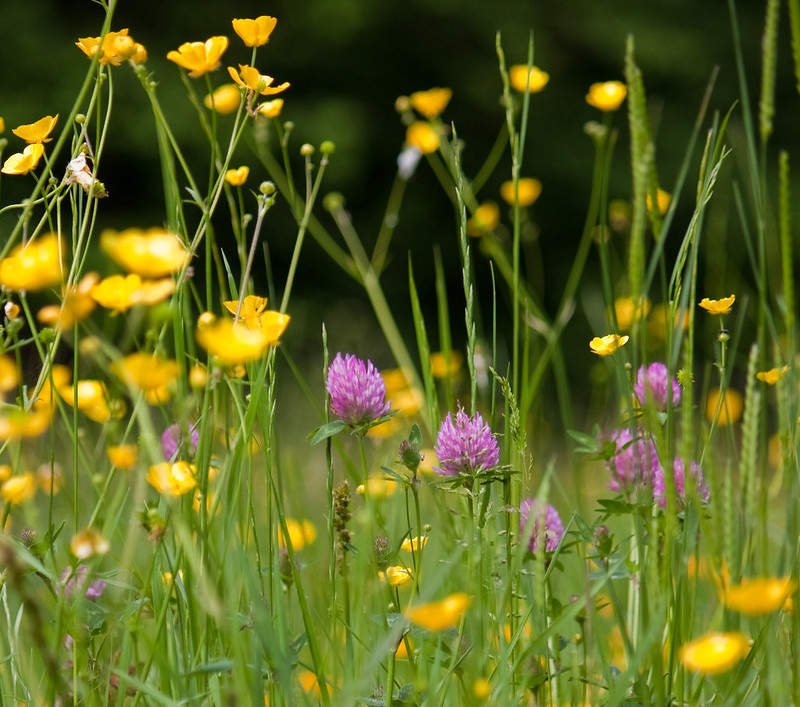
Benefits of rewilding a lawn
We stopped mowing our lawn. I thought it won’t look good, but it did. Paths with short grass naturally formed where we walked through the garden. Around them grass grew somewhat taller, producing graceful seed heads. In the grass wild flowers sprouted naturally.
It was not a colourful meadow, at least in its first year. But there were sunny dandelions in early spring, buttercups in May, ox-eye daisies and self-heal with its brown-purple flowers in June and July. Wild sorrel sprang in several places, so there was plenty for salads and domestic needs. For the first time ever I could hear crickets in our grass.
There seem to have been an almost immediate beneficial effect on the soil. It is very prone to dryness, but less watering was necessary in the summer in spite of weeks without rain. In winter I could see worm casts almost everywhere – this did not happen before and is great for the soil. There were many more insects then previously. The joy of it all means that I will not go back to the old lawn. It’s green mono-culture now looks boring and unnatural.
I also greatly enjoyed not having to mow the grass every week. It was my least favourite job and I can now spend time on something more creative.
How to care for a natural lawn
In terms of maintenance, the grass started to look tired in August, partly due to heat and dry weather, now usual in the summer. I mowed it then, the only time in the entire season. It grew a little more in warm September and early October, but this growth died off naturally when the weather turned cold. In January the grass was short, ready for crocuses and daffodils, just as it was when it was diligently mowed.
If you stop mowing your lawn, it is of course possible to plant in it more vigorous wild flower species, bought in pots from nurseries. This could include primulas, ox-eye daisy, tansy or elecampane. It is also a great idea to plant spring bulbs in the lawn.
4. Annual wild flower meadow
If you have an area in your garden that you would like to dedicate to wild flowers, an annual meadow could be a good solution. It is great for a quick result. It will flower the same year, 2-3 months after sowing. If necessary, after a year the area can be returned to another use.
An annual meadow requires quite a lot of work in spring, but many people enjoy such work, and the result can be stunningly colourful and beautiful.
Plants that flower prolifically and will look effective in such planting require a lot of energy. So for an annual meadow you really need an open sunny position. The plants also need the sun to grow fast to flower in their first season and to grow strong to stay upright in rain and wind.
Meadow plants require poor soil. If the soil is rich they will grow too tall, and will not be able to support themselves without staking. So it is important not to use any fertilizers.
Seed mixtures for annual meadows are widely available or you can make your own. The mixtures usually include poppy, cornflower and corn marigold, as well as some garden flowers, such as cosmos, sun flowers and zinnias.
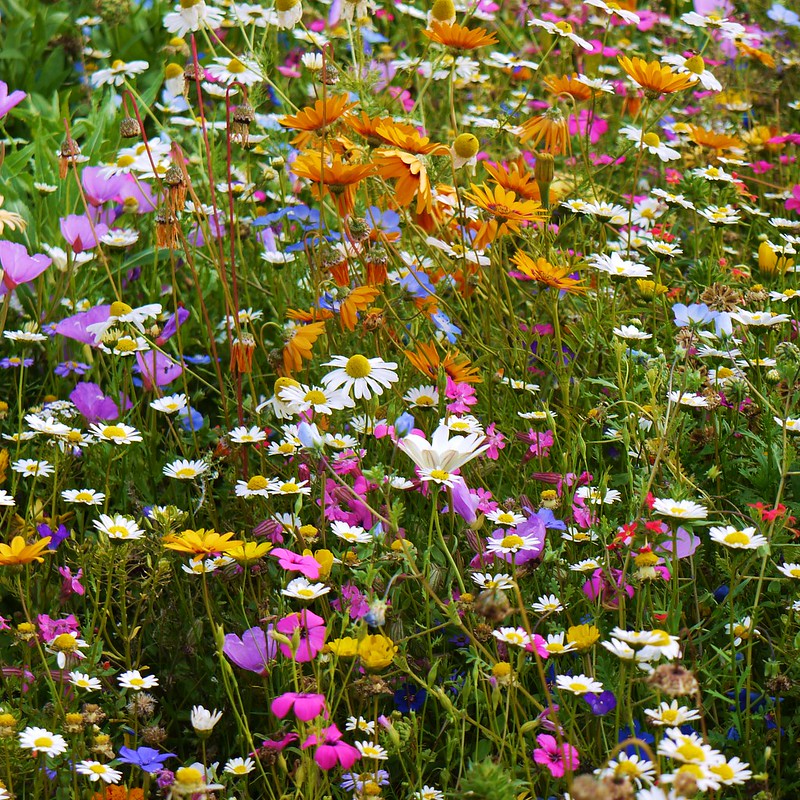
How to plant an annual wild flower meadow
The meadow need to be planted in spring. Dig the area over and rake it, so that the surface is even. Sprinkle the correct quantity of seeds, as required by growing instructions. Rake them in lightly, by running the rake 2 or 3 times over the surface. The seeds should be covered with 1-2 cm of soil. It does not matter if some remain uncovered on the surface.
Ideally firm the surface by pressing on it with a wood plank or a garden roller. This will give the seeds a better contact with soil and they will germinate and grow more evenly.
Water and keep watering for the next six weeks.
The plants will flower, produce seeds and die off in Autumn. Collect the seeds and repeat the process again next year.
5. Perennial wild flower meadow
Since this will be a long term, low maintenance feature in the garden, it is worth making an effort to get it right from the start.
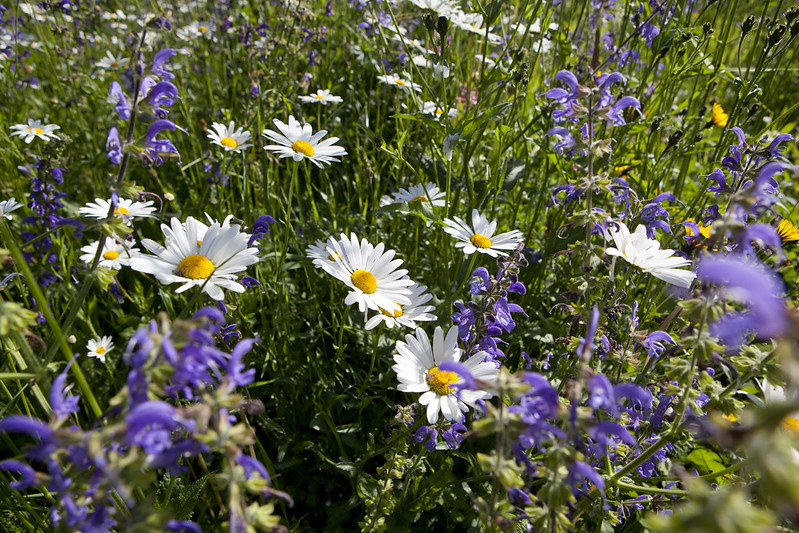
Choosing the right position
Meadow plants require an open sunny situation.
Most prefer well-drained soil, though there are those that require a lot of moisture, such as loosestrife or meadowsweet. It is important to buy or make your own seed mixture appropriate for your conditions.
Wild flowers also require poor soil. In such soil they can compete with grasses as it happens in nature. In natural meadows grasses grow side by side with other flowering plants and don’t overwhelm them. However, in nitrogen-rich soils that have been repeatedly fertilized with natural or chemical fertilizers, grasses and vigorous ‘pioneer’ plants, such as nettles, quickly squeeze out wild flowers. On rich soil a meadow will therefore quickly turn into a jungle of tall grass and weeds.
If you are converting a part of your lawn, the soil is likely to be poor already. The best way to make it poor, is not to use any fertilizers, repeatedly mow the grass and remove the cuttings.
If your soil is rich, because natural or chemical fertilizers were repeatedly applied, growing a few large wild flower perennials in a border may be a better solution. Elecampane, geraniums or chicory would be excellent choices. They will not need any care apart from cutting down dead stems once a year in late autumn of early spring.
Planting a perennial wild flower meadow
Perennial meadow seed mixes combine wild flowers and grasses that are not too vigorous and naturally grow with wild flowers. Seed mixtures for lawns, on the contrary, include grasses that are very vigorous, designed to eliminate other species, and survive damage from walking. They are best avoided.
The seeds can be planted either in autumn or in spring. The process is similar to planting a lawn. But before you sow, it is important to eliminate any weeds and competitors that may otherwise kill the wild flowers before they get a chance to grow. This process, if done without harmful chemicals, will take about 3 months.
If you are converting a part of a lawn, you could do the following:
- Cover the area with cardboard to exclude light. Leave it for 4-8 weeks. This will kill all perennial plants, including fast growing grasses, that would otherwise compete with meadow plants.
- Dig it over, water and leave. Annual weed seeds will sprout. Destroy them with a rake and remove.
- Meadow plants do well in sandy soils. An addition of sand makes the soil more breathable, less fertile and better drained. This is an optional step, but if possible, cover the soil with 2-3cm of large-grain sand and rake it in.
- Sprinkle the correct amount of seeds, according to growing instructions. Rake the seeds in lightly by running the rake over the surface of the area 2 or 3 times. The seeds should be covered with 1-2cm of soil.
- Firm with soil again with a garden roller or a wooden plank – this will give the seeds a better contact with soil and ensure even germination and growth.
- Water and keep moist for 6 weeks.
Most perennial plants will not flower in their first year, so the meadow will come into its own only in its second year.
How to care for a wild flower meadow
Cut in autumn or August, or if necessary in both, depending on your conditions and whether the meadow still looks good or not.
It is important not to cut too early to let the plants produce seeds. If cutting in August, leave the cuttings for 2-3 days to dry, shake off any seeds and remove.
When mowing, cut the plants to 5-10cm. The area will quickly turn green and look not that different form a traditional lawn.
Can you just sprinkle wild flower seeds in a lawn?
In my experience this sadly does not work. This is because lawn grasses with very developed root systems quickly suppress any newcomers.
Wild flowers can grow well with such grasses such as bentgrass (Agrostis) and festuca, that don’t compete with them and will not overwhelm them. Meadow seed mixtures contain such grasses.
Seed mixtures for lawns usually contain grasses that are very vigorous and designed to eliminate other plants. Most commonly this is ryegrass (Lolium perenne). Wild flowers have little chance of surviving such competition. Therefore planting seeds or even small young plants in an existing lawn is unlikely to work.
This is, but the way, one of the reasons why many fields used as pastures look so boring and don’t have any flowers. Typically they have been ‘improved’ by sowing ryegrass and adding fertilizers that create good conditions for vigorous nitrogen-loving species, such as grasses and nettles. But such conditions eliminate wild flowers.
Yellow rattle – a secret weapon for suppressing grass
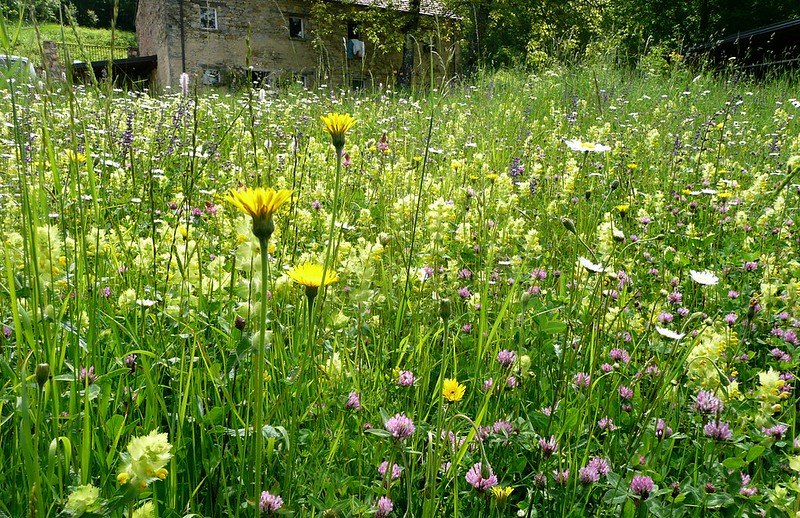
A plant called yellow rattle is used by conservationists and garden designers to suppress grass and give the wild flowers an opportunity to compete. It is a semi-parasitic plant that weakens grasses by as much as 50%. It is very attractive and a lovely addition to any meadow. Make sure you include its seeds in your mixture. Also don’t mow your meadow until August to let yellow rattle to self-seed.
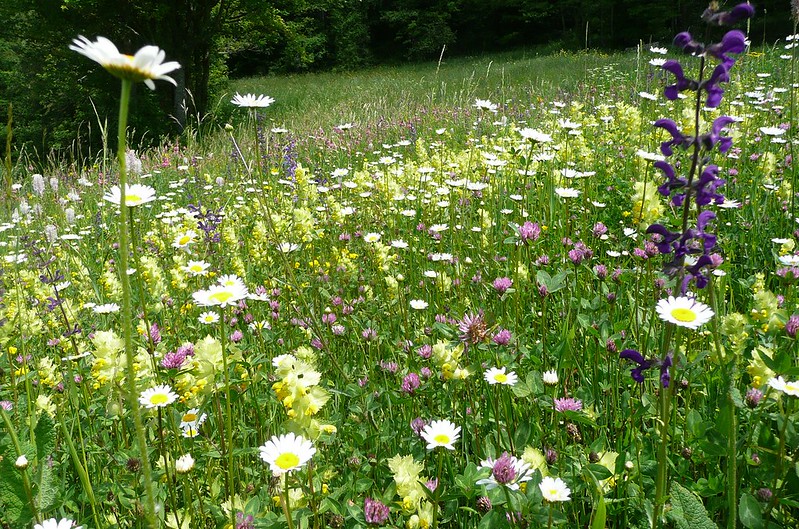
Dealing with invasive species
Some of my favourite wild flowers, that I all grow in my garden, are capable of spreading very quickly. These include tansy, colt’s foot, dandelion and rosebay willowherb.
These look particularly wonderful planted en masse. Tansy is just as beautiful as many chrysanthemums, looks wonderful in flower arrangements and, unlike chrysanthemums, does not require any care. Rosebay willowherb looks stunning when it flowers in July and and is wonderful in a large vase or a jug.
If, however, you have little space, they may not be for you. I grow both tansy and rosebay willowherb in borders, together with other tall plants, because I like the look so much. But it is more work – you need to watch that they don’t overwhelm other plants and cut them back if necessary.
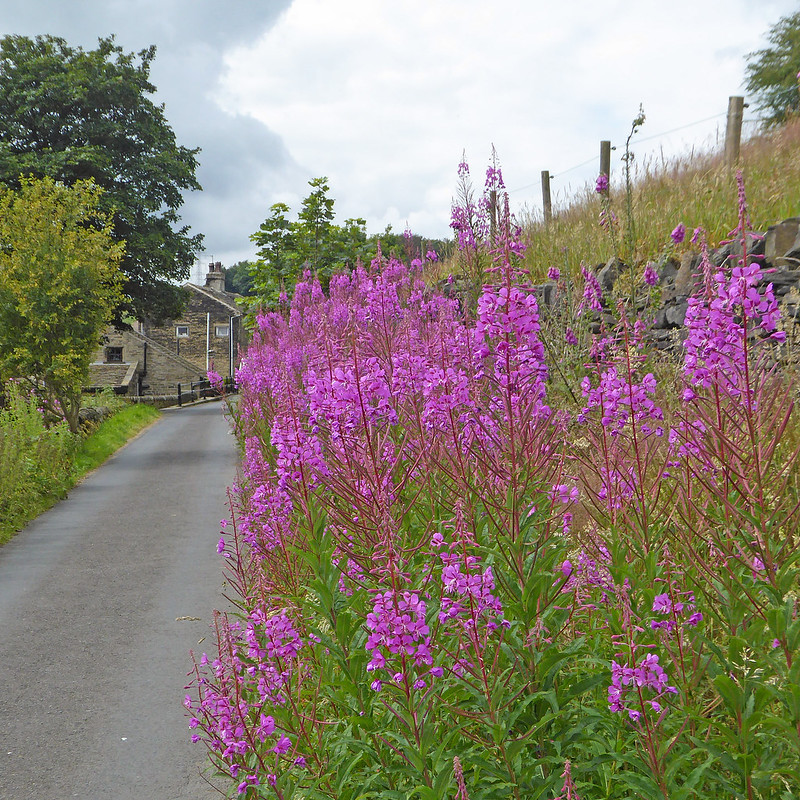
If you have an area where they can be left to spread, they are a wonderful choice for an informal garden. They both look best in full sun, but can cope with some shade. Because they are tall, attention grabbing, vigorous and very undemanding, they can be used to mask unattractive features, such as compost bins.
I always let dandelions grow in lawns – its is a most uplifting sight when they flower in spring. I also always use them in salads.
Other species that look beautiful, but can be invasive are ox-eye daisy and forget-me-not that self-seed very easily. Colt’s foot quickly spreads its roots in almost any soil in a sunny situation.
Spring bulbs in a wild flower garden
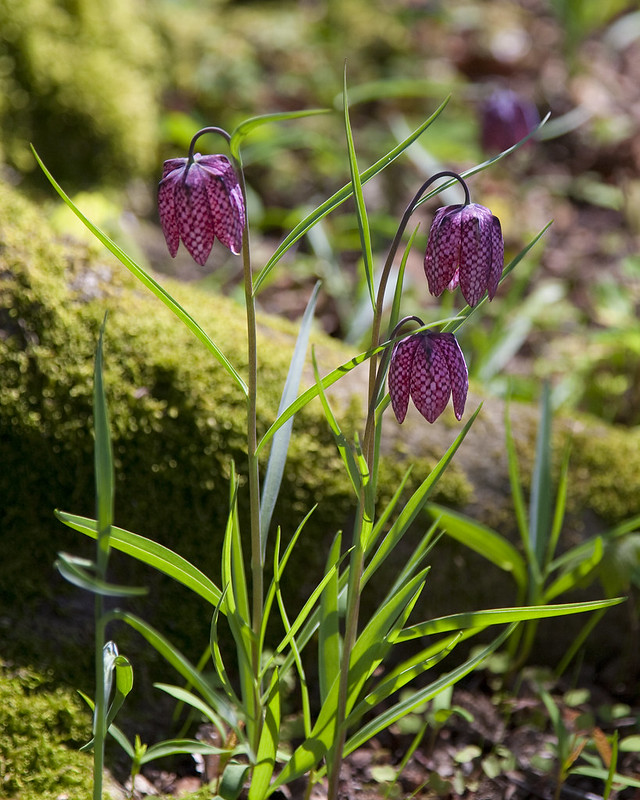
Spring bulbs flower before most plants start growing in spring. They therefore do not compete with other species. As other plants grow, they hide the yellowing foliage of the bulbs. So it is a win-win situation. Wild flower bulbs, excellent for lawns and meadows, include species crocuses and daffodils, species tulips, snowdrops, winter aconites, bluebells and snakeshead fritillaries. Bluebells and wild garlic are best planted under deciduous trees where they can have sun in spring and shade in the summer.
Related posts
Small Scale Rewilding: How to Rewild your Garden
Medicinal Wild Flowers for your Garden
Best wild flowers to grow in the garden
Best Wild Flowers for Bees and Butterflies
45 Edible Flowers for Baking, Cakes, Cocktails, Salads and More
‘Wilding’ by Isabella Tree: a Review
What is Nectar: Basics for a Bee-Lover
How to Attract Sparrows to your Garden
Organic Pest Control: Sanctuaries for Beneficial Insects
Pin ‘How to Grow Wild Flowers in the Garden’ for later
